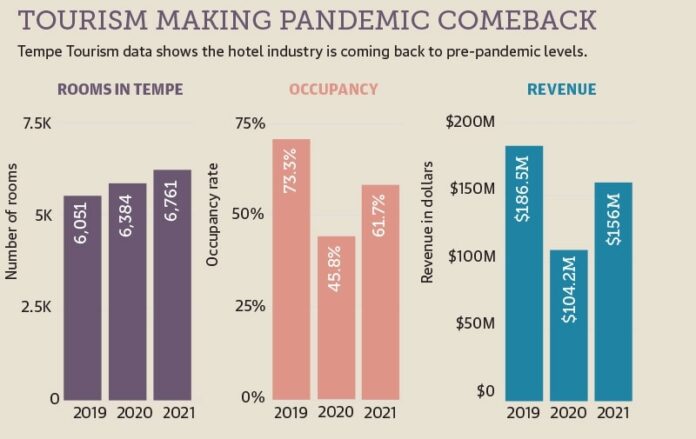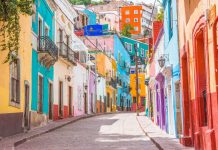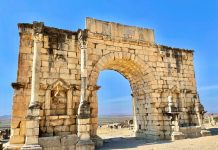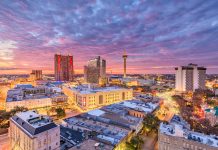Ryan Kirby, general manager of the recently opened The Westin Tempe, said opening a hotel in a pandemic was difficult. The hotel made its debut in late August, and Kirby said the hotel was riding the wave of several coronavirus variants halting travel for many.
“As a hotel industry, and the world overall, we had to find ways to ride this roller coaster up and down and navigate it as best we could,” Kirby said. “We were struggling with occupancy. We would see it at 100% at [Arizona State University’s] parents’ weekend and then down to 30% or 40% occupancy the next weekend. Thankfully, I feel like we are rising again and have a bright future.”
The Westin Tempe was one of two new hotels that opened in the last 12 months in Tempe, the other a product of Best Western called The Vib, which opened in March. The Canopy by Hilton opened in downtown Tempe in June 2020, and another hotel—The Omni Tempe Hotel—is under construction. By spring 2023, the city will have added about 1,000 new hotel rooms to its existing inventory.
Michael Martin, interim president and CEO of Tempe Tourism, said the Tempe hospitality industry was hit hard by the pandemic in 2020, with hotel occupancy dipping across the board. Visitations fell 32.5% in 2020, according to data from Tempe Tourism. Visitor volume dropped to 2.8 million from 4.2 million the previous year.
“We are a business destination,” Martin said. “Prior to the pandemic, our business stays made up a majority of our occupancy. In the pandemic, business travel went way down. But we’ve seen something interesting, and that’s our leisure travel outpacing business travel in pandemic recovery. I think there was pent-up demand for people to get out of their bubble.”
Martin said he is optimistic that as events continue to draw people to Tempe and as businesses resume travel and in-person meetings, the local hospitality industry will continue to improve.
Making a comeback
Martin said while business travel has not yet come back all the way in Tempe, the industry is doing well despite it.
“When business travel comes back, at this point, it will be icing on the cake,” Martin said.
Martin said local hotels, especially those near downtown Tempe and Tempe Town Lake, are seeing an increase in interest in their meeting spaces for conferences and that in the last couple months more business travel has occurred nationally and locally.
“That is a sign we have turned a corner,” Martin said.
There is more diversity in the kind of traveler Tempe sees than one might think, Martin said.
“I don’t think people get that all our travel isn’t just because of ASU,” Martin said. “People come here for a getaway or an event. ASU does play a role, [but travelers come for a variety of reasons.]
Jill Buschbacher, economic development program manager for the city of Tempe, said the city’s events play such an important role in tourism that with events canceled and postponed during the pandemic, the industry was hit hard.
“Events attract so many of our visitors to Tempe,” Buschbacher said. “It was difficult during the pandemic.”
According to data from Tempe Tourism, hotel occupancy fell to 45.6% for 2020 from 73.3% in 2019. The average daily rate for rooms also dropped about 9% in 2020, according to the data.
In 2021, occupancy in Tempe hotels increased to 61.7%, according to the Tempe Tourism data. Buschbacher said tax revenue from tourism has also been picking up.
More than hotel stays
Colin Diaz, president and CEO of the Tempe Chamber of Commerce, said the economic impact of tourism in the city of Tempe is widespread beyond the vacancy rates of hotels.
“For small to mid-size businesses, foot traffic is key,” Diaz said. “People staying in hotels might ask where the best places to go are. When there are more people in the area, that is good for those businesses; so is that word of mouth.”
Buschbacher said tourism is a vital part of the city’s economy. Visitors to Tempe spent nearly $884 million in 2019, 3.8% more than in 2018. This direct spending generated $1.2 billion in total business sales, including indirect and induced impacts, according to Tempe Tourism.
Hotel stays also generate tax revenue for the city. In January, the city generated $1.8 million in hotel-motel tax revenue, according to city records, a year-over-year increase of 120%.
The temporary move of the Arizona Coyotes NHL games to ASU is expected to impact tourism in the city as well. The hockey team is in talks with the city of Tempe about a potential facility in Tempe after leaving its Glendale facility in spring 2022. Diaz said talks are still “fluid,” but should an arena be built, it would certainly impact tourism in Tempe.
“It would bring a lot of jobs; I think the estimated economic impact is $10 [million] or $11 million a year,” Diaz said. “It could generate construction jobs, jobs at the venue—it would make another attraction for the city. … There are still a lot of conversions to be had, but it could be impactful for tourism in the city.”
Martin said Tempe is truly a destination for visitors, and he expects that should pandemic conditions remain the same, the city’s tourism industry is poised to rebound well.
“With ASU, sports, meeting space, our outdoor amenities, museums, ASU Gammage and Tempe Center for the Arts, we are a destination,” Martin said. “I think we will continue to see demand going up.”










